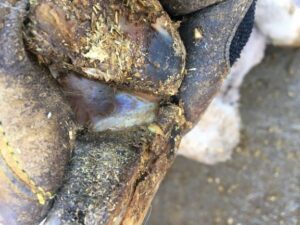Springtime in Australia represents the time when many sheep producers are out buying and selling stud stock and planning next year’s breeding programs. It is also the time of year in much of temperate Australia when some of the more common endemic diseases of sheep become more noticeable and prevalent.
It is vitally important that both purchasers and sellers of sheep understand what their current disease statuses are for production limiting diseases and there are steps we should all take to aid in the prevention and management of disease.
Some diseases, like sheep lice and footrot can be observed through physical inspections performed by someone with a trained eye. Others like Johne’s Disease (JD) and Ovine Brucellosis (OB) often require confirmatory testing through a vet. It is fair to say that sheep producers across Australia have different levels of concern around many diseases of sheep, depending on their local area prevalence, current flock status and the ease or difficulty of eradication if disease does enter our flock.
Stud sheep, despite what many may think, are not immune to disease incursions and as stud breeders sell to a vast number of clients spread right across the country, it’s important to ensure you know the status of disease within the stud and protect clients from possible disease incursions. Turning a blind eye to a problem or assuming disease isn’t present really isn’t good enough when it comes to sound biosecurity practices.
Here are some simple management practices that can be employed to protect your stud flock, and your clients:-
#1:
For diseases you can’t see, such as internal parasites - Ovine Brucellosis and Johne’s Disease - test your flock regularly, to assure yourself and your clients that these diseases aren’t present. Programs like the Ovine Brucellosis Accreditation Scheme and Market Assurance Programs lend some structure and assurance to this testing. For internal parasites, implement a sound testing and treatment program to avoid passing on drench resistant worms.
#2:
For disease you can detect visually, inspect your sheep regularly during the peak spread period.
Footrot tends to proliferate during warmer, wet conditions. Investigate lameness and determine the cause, tip sheep and closely inspect the hooves and skin between the claws for hair loss, wetness and separation of the shell of the hoof. Seek advice from vets and government Animal Health advisers if you are unsure.
Remember that footrot can appear as fairly inconspicuous interdigital lesions early in the spread season, that may develop further and spread quickly throughout a flock.
Lice are most easily detected just prior to shearing, when populations are at their highest and sheep lice favour the cooler months. Physically inspect sheep for lice by performing at least 20 parts of the fleece, looking for the light brown coloured slow-moving lice on the skin at the base of the part. Even the detection of one louse, indicates treatment will be required. For both these diseases inspect a large number of sheep, to satisfy yourself there is no issue.
 Early low grade footrot lesion showing only mild interdigital hair loss and blanching of the epithelial skin between the claws.
Early low grade footrot lesion showing only mild interdigital hair loss and blanching of the epithelial skin between the claws.
 Adult sheep lice at the base of the wool staple.
Adult sheep lice at the base of the wool staple.
#3
When introducing stock to your property, ensure you are satisfied with the disease status declared by the seller and request a Sheep Health Declaration. Determine if sheep have been vaccinated for the diseases you are concerned about and note which vaccines you may need to administer post purchase. Conduct physical inspections prior to purchase. You wouldn’t purchase a car without a test drive, so why purchase replacement sheep without inspecting for those diseases you can detect visually.
#4
Consider foot bathing sheep in an antibacterial solution such as Zinc Sulphate upon arrival and after inspection. They may not be coming from a property with an issue, but you never know what has been on the truck or in the yards prior to transport.
#5
Isolate newly purchased sheep for at least 2 weeks after arrival and longer if possible. This will enable you to monitor their health and perhaps detect a developing problem before is spreads to your whole flock.
#6
Use a quarantine drench on arrival to minimise the impact and spread of internal parasites and administer vaccine boosters for clostridial disease as well as vaccinations for Johne’s Disease and Scabby Mouth if these diseases are an issue for you.
#7
Ensure sheep are transferred to your property on the National Livestock Identification Database and always seek a movement document or National Vendor Declaration from the seller prior to moving sheep to your property.
Farm biosecurity plans are now required nationally through the Livestock Production Assurance - Integrity Systems program, these plans provide a good summary of the biosecurity practices you should employ to reduce the threat of disease incursion, so complete one and refer to it regularly.
You can find more information on how to create a Farm Biosecurity plan, including a template here.
Remember, there are many disease challenges we need to face in the sheep industry. If you do detect an issue, don’t bury your head in the sand. Detect early, seek advice, manage the incursion, minimise the impact and importantly share your experiences and successes.